Report: Managing Continuous Organisational Improvement at Unilever
VerifiedAdded on 2021/02/21
|13
|4075
|50
Report
AI Summary
This report examines Unilever's approach to managing continuous organizational improvement. It begins by defining organizational culture and its role in fostering continuous improvement, highlighting features like communication and research and development. The report then explores various change management approaches, including education, participation, and negotiation, as applied by Unilever. It also delves into continuous quality improvement strategies like benchmarking and Total Quality Management. The report analyzes how leadership and management styles, particularly democratic styles, facilitate improvement. Furthermore, it emphasizes the importance of continuous improvement for organizational success, discussing its impact on employee engagement, turnover, and customer service. The report identifies sources of information used to identify areas for improvement, including the internet and newspapers, and explains the meaning and contribution of Big Data to improvement strategies. Finally, the report reviews information to identify areas for improvement within the organization and explores the potential benefits of proposed changes.
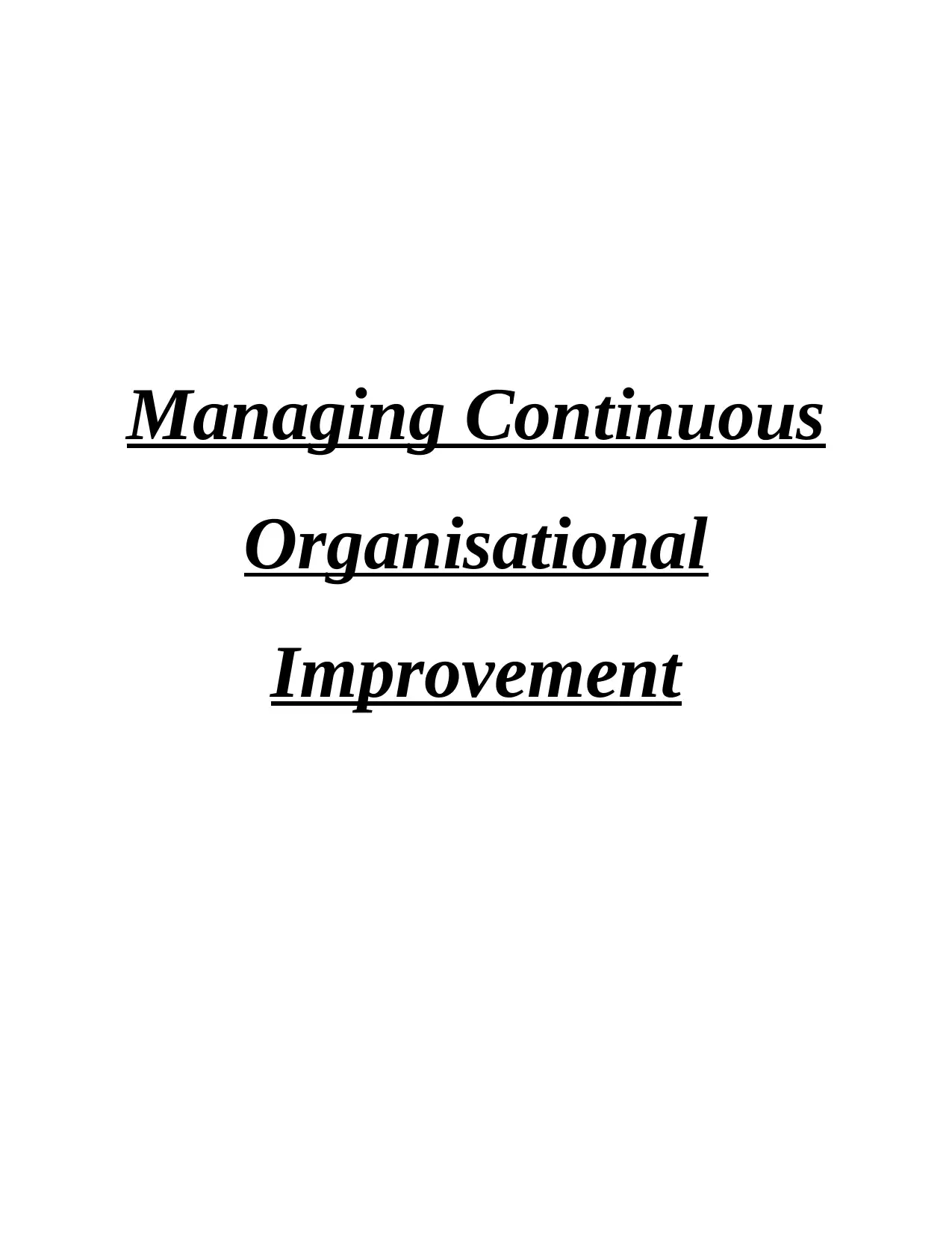
Managing Continuous
Organisational
Improvement
Organisational
Improvement
Paraphrase This Document
Need a fresh take? Get an instant paraphrase of this document with our AI Paraphraser
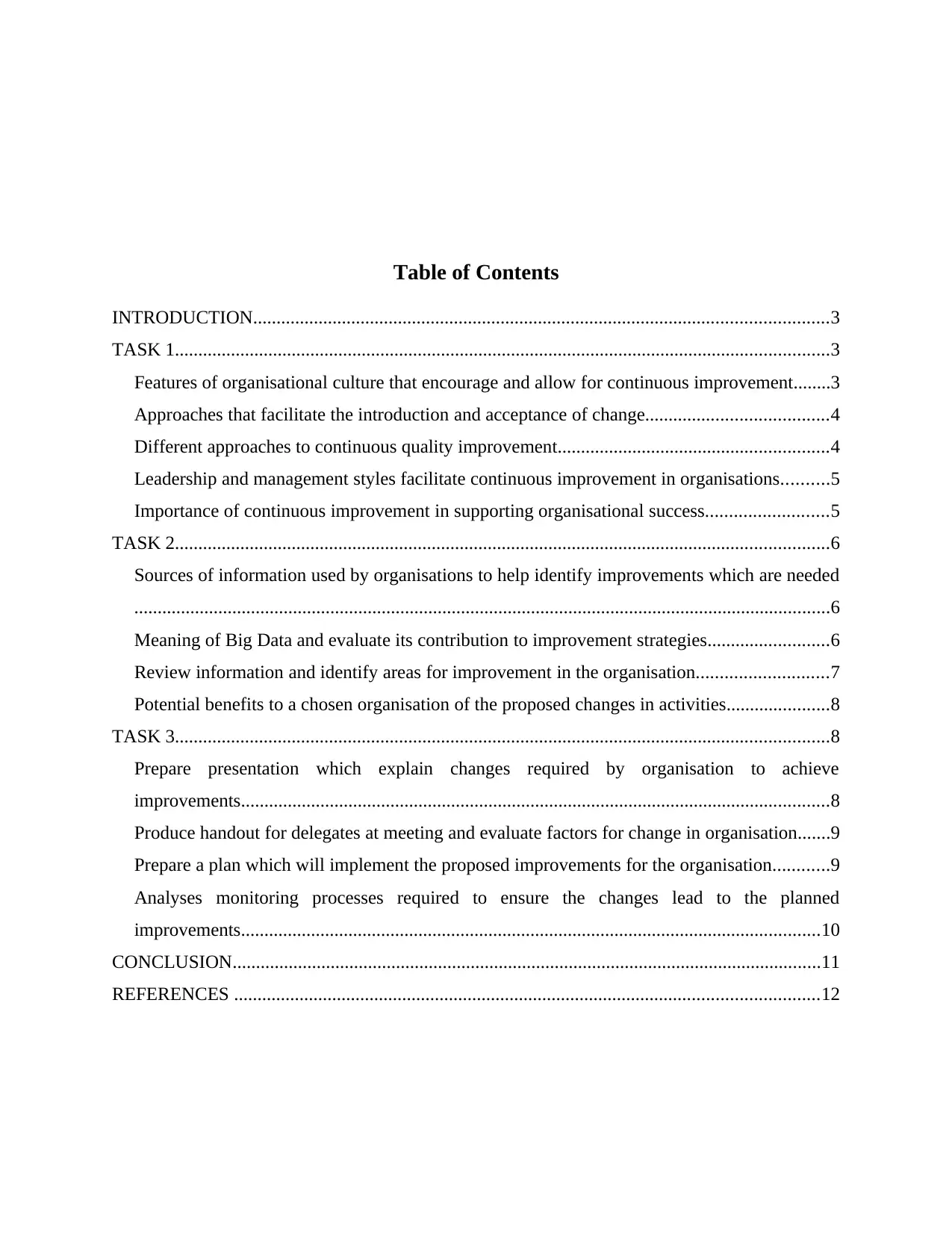
Table of Contents
INTRODUCTION...........................................................................................................................3
TASK 1............................................................................................................................................3
Features of organisational culture that encourage and allow for continuous improvement........3
Approaches that facilitate the introduction and acceptance of change.......................................4
Different approaches to continuous quality improvement..........................................................4
Leadership and management styles facilitate continuous improvement in organisations..........5
Importance of continuous improvement in supporting organisational success..........................5
TASK 2............................................................................................................................................6
Sources of information used by organisations to help identify improvements which are needed
.....................................................................................................................................................6
Meaning of Big Data and evaluate its contribution to improvement strategies..........................6
Review information and identify areas for improvement in the organisation............................7
Potential benefits to a chosen organisation of the proposed changes in activities......................8
TASK 3............................................................................................................................................8
Prepare presentation which explain changes required by organisation to achieve
improvements..............................................................................................................................8
Produce handout for delegates at meeting and evaluate factors for change in organisation.......9
Prepare a plan which will implement the proposed improvements for the organisation............9
Analyses monitoring processes required to ensure the changes lead to the planned
improvements............................................................................................................................10
CONCLUSION..............................................................................................................................11
REFERENCES .............................................................................................................................12
INTRODUCTION...........................................................................................................................3
TASK 1............................................................................................................................................3
Features of organisational culture that encourage and allow for continuous improvement........3
Approaches that facilitate the introduction and acceptance of change.......................................4
Different approaches to continuous quality improvement..........................................................4
Leadership and management styles facilitate continuous improvement in organisations..........5
Importance of continuous improvement in supporting organisational success..........................5
TASK 2............................................................................................................................................6
Sources of information used by organisations to help identify improvements which are needed
.....................................................................................................................................................6
Meaning of Big Data and evaluate its contribution to improvement strategies..........................6
Review information and identify areas for improvement in the organisation............................7
Potential benefits to a chosen organisation of the proposed changes in activities......................8
TASK 3............................................................................................................................................8
Prepare presentation which explain changes required by organisation to achieve
improvements..............................................................................................................................8
Produce handout for delegates at meeting and evaluate factors for change in organisation.......9
Prepare a plan which will implement the proposed improvements for the organisation............9
Analyses monitoring processes required to ensure the changes lead to the planned
improvements............................................................................................................................10
CONCLUSION..............................................................................................................................11
REFERENCES .............................................................................................................................12
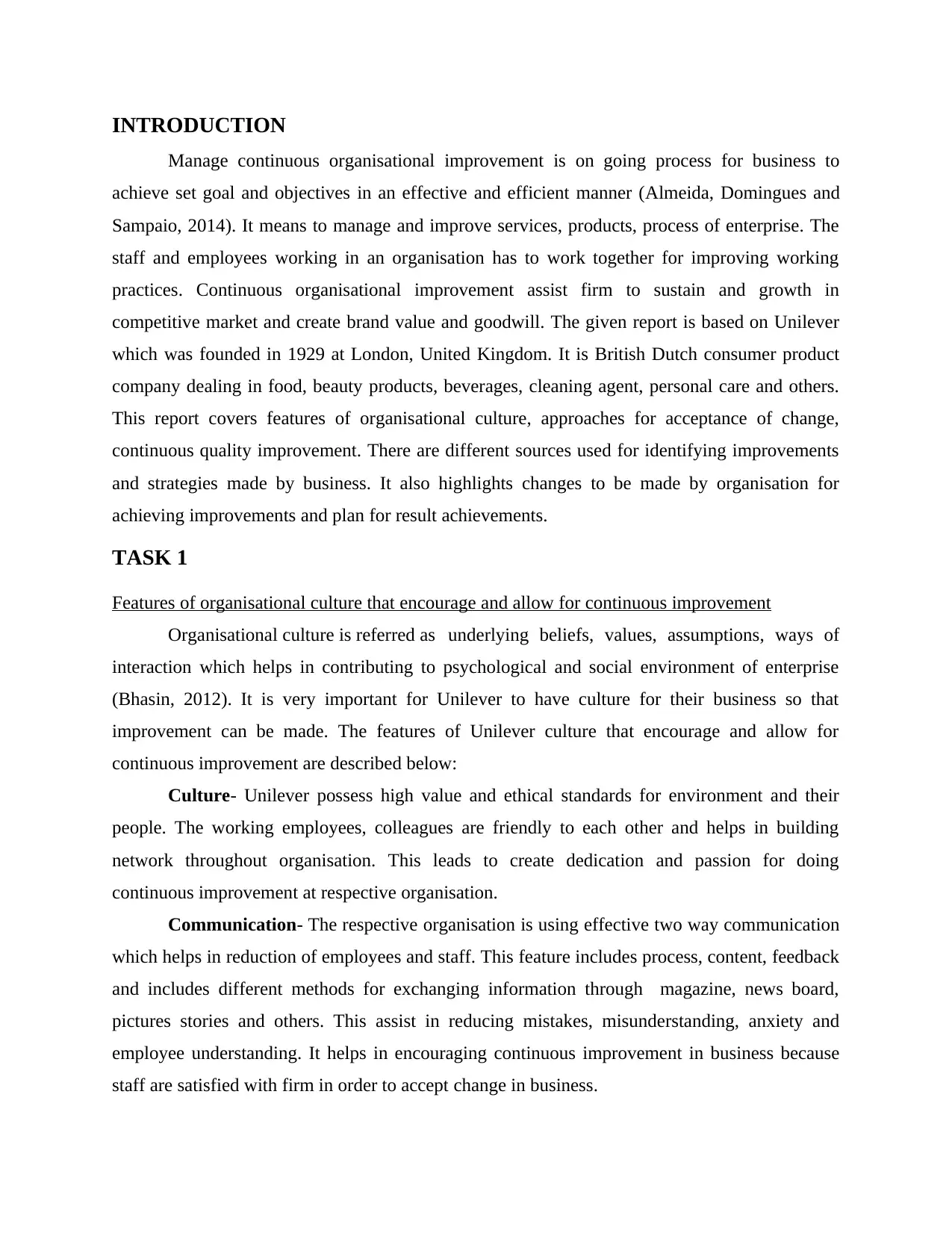
INTRODUCTION
Manage continuous organisational improvement is on going process for business to
achieve set goal and objectives in an effective and efficient manner (Almeida, Domingues and
Sampaio, 2014). It means to manage and improve services, products, process of enterprise. The
staff and employees working in an organisation has to work together for improving working
practices. Continuous organisational improvement assist firm to sustain and growth in
competitive market and create brand value and goodwill. The given report is based on Unilever
which was founded in 1929 at London, United Kingdom. It is British Dutch consumer product
company dealing in food, beauty products, beverages, cleaning agent, personal care and others.
This report covers features of organisational culture, approaches for acceptance of change,
continuous quality improvement. There are different sources used for identifying improvements
and strategies made by business. It also highlights changes to be made by organisation for
achieving improvements and plan for result achievements.
TASK 1
Features of organisational culture that encourage and allow for continuous improvement
Organisational culture is referred as underlying beliefs, values, assumptions, ways of
interaction which helps in contributing to psychological and social environment of enterprise
(Bhasin, 2012). It is very important for Unilever to have culture for their business so that
improvement can be made. The features of Unilever culture that encourage and allow for
continuous improvement are described below:
Culture- Unilever possess high value and ethical standards for environment and their
people. The working employees, colleagues are friendly to each other and helps in building
network throughout organisation. This leads to create dedication and passion for doing
continuous improvement at respective organisation.
Communication- The respective organisation is using effective two way communication
which helps in reduction of employees and staff. This feature includes process, content, feedback
and includes different methods for exchanging information through magazine, news board,
pictures stories and others. This assist in reducing mistakes, misunderstanding, anxiety and
employee understanding. It helps in encouraging continuous improvement in business because
staff are satisfied with firm in order to accept change in business.
Manage continuous organisational improvement is on going process for business to
achieve set goal and objectives in an effective and efficient manner (Almeida, Domingues and
Sampaio, 2014). It means to manage and improve services, products, process of enterprise. The
staff and employees working in an organisation has to work together for improving working
practices. Continuous organisational improvement assist firm to sustain and growth in
competitive market and create brand value and goodwill. The given report is based on Unilever
which was founded in 1929 at London, United Kingdom. It is British Dutch consumer product
company dealing in food, beauty products, beverages, cleaning agent, personal care and others.
This report covers features of organisational culture, approaches for acceptance of change,
continuous quality improvement. There are different sources used for identifying improvements
and strategies made by business. It also highlights changes to be made by organisation for
achieving improvements and plan for result achievements.
TASK 1
Features of organisational culture that encourage and allow for continuous improvement
Organisational culture is referred as underlying beliefs, values, assumptions, ways of
interaction which helps in contributing to psychological and social environment of enterprise
(Bhasin, 2012). It is very important for Unilever to have culture for their business so that
improvement can be made. The features of Unilever culture that encourage and allow for
continuous improvement are described below:
Culture- Unilever possess high value and ethical standards for environment and their
people. The working employees, colleagues are friendly to each other and helps in building
network throughout organisation. This leads to create dedication and passion for doing
continuous improvement at respective organisation.
Communication- The respective organisation is using effective two way communication
which helps in reduction of employees and staff. This feature includes process, content, feedback
and includes different methods for exchanging information through magazine, news board,
pictures stories and others. This assist in reducing mistakes, misunderstanding, anxiety and
employee understanding. It helps in encouraging continuous improvement in business because
staff are satisfied with firm in order to accept change in business.
⊘ This is a preview!⊘
Do you want full access?
Subscribe today to unlock all pages.

Trusted by 1+ million students worldwide
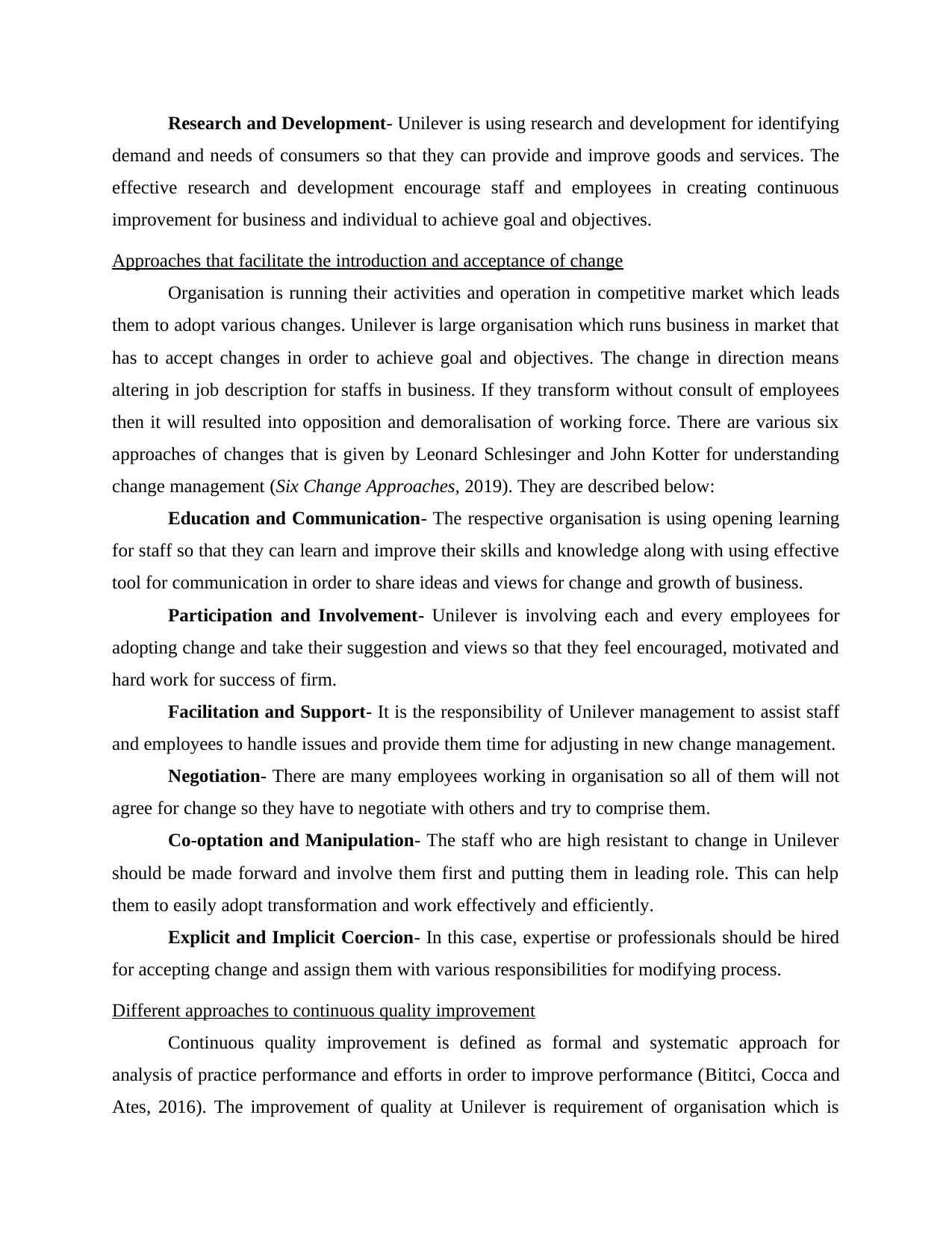
Research and Development- Unilever is using research and development for identifying
demand and needs of consumers so that they can provide and improve goods and services. The
effective research and development encourage staff and employees in creating continuous
improvement for business and individual to achieve goal and objectives.
Approaches that facilitate the introduction and acceptance of change
Organisation is running their activities and operation in competitive market which leads
them to adopt various changes. Unilever is large organisation which runs business in market that
has to accept changes in order to achieve goal and objectives. The change in direction means
altering in job description for staffs in business. If they transform without consult of employees
then it will resulted into opposition and demoralisation of working force. There are various six
approaches of changes that is given by Leonard Schlesinger and John Kotter for understanding
change management (Six Change Approaches, 2019). They are described below:
Education and Communication- The respective organisation is using opening learning
for staff so that they can learn and improve their skills and knowledge along with using effective
tool for communication in order to share ideas and views for change and growth of business.
Participation and Involvement- Unilever is involving each and every employees for
adopting change and take their suggestion and views so that they feel encouraged, motivated and
hard work for success of firm.
Facilitation and Support- It is the responsibility of Unilever management to assist staff
and employees to handle issues and provide them time for adjusting in new change management.
Negotiation- There are many employees working in organisation so all of them will not
agree for change so they have to negotiate with others and try to comprise them.
Co-optation and Manipulation- The staff who are high resistant to change in Unilever
should be made forward and involve them first and putting them in leading role. This can help
them to easily adopt transformation and work effectively and efficiently.
Explicit and Implicit Coercion- In this case, expertise or professionals should be hired
for accepting change and assign them with various responsibilities for modifying process.
Different approaches to continuous quality improvement
Continuous quality improvement is defined as formal and systematic approach for
analysis of practice performance and efforts in order to improve performance (Bititci, Cocca and
Ates, 2016). The improvement of quality at Unilever is requirement of organisation which is
demand and needs of consumers so that they can provide and improve goods and services. The
effective research and development encourage staff and employees in creating continuous
improvement for business and individual to achieve goal and objectives.
Approaches that facilitate the introduction and acceptance of change
Organisation is running their activities and operation in competitive market which leads
them to adopt various changes. Unilever is large organisation which runs business in market that
has to accept changes in order to achieve goal and objectives. The change in direction means
altering in job description for staffs in business. If they transform without consult of employees
then it will resulted into opposition and demoralisation of working force. There are various six
approaches of changes that is given by Leonard Schlesinger and John Kotter for understanding
change management (Six Change Approaches, 2019). They are described below:
Education and Communication- The respective organisation is using opening learning
for staff so that they can learn and improve their skills and knowledge along with using effective
tool for communication in order to share ideas and views for change and growth of business.
Participation and Involvement- Unilever is involving each and every employees for
adopting change and take their suggestion and views so that they feel encouraged, motivated and
hard work for success of firm.
Facilitation and Support- It is the responsibility of Unilever management to assist staff
and employees to handle issues and provide them time for adjusting in new change management.
Negotiation- There are many employees working in organisation so all of them will not
agree for change so they have to negotiate with others and try to comprise them.
Co-optation and Manipulation- The staff who are high resistant to change in Unilever
should be made forward and involve them first and putting them in leading role. This can help
them to easily adopt transformation and work effectively and efficiently.
Explicit and Implicit Coercion- In this case, expertise or professionals should be hired
for accepting change and assign them with various responsibilities for modifying process.
Different approaches to continuous quality improvement
Continuous quality improvement is defined as formal and systematic approach for
analysis of practice performance and efforts in order to improve performance (Bititci, Cocca and
Ates, 2016). The improvement of quality at Unilever is requirement of organisation which is
Paraphrase This Document
Need a fresh take? Get an instant paraphrase of this document with our AI Paraphraser
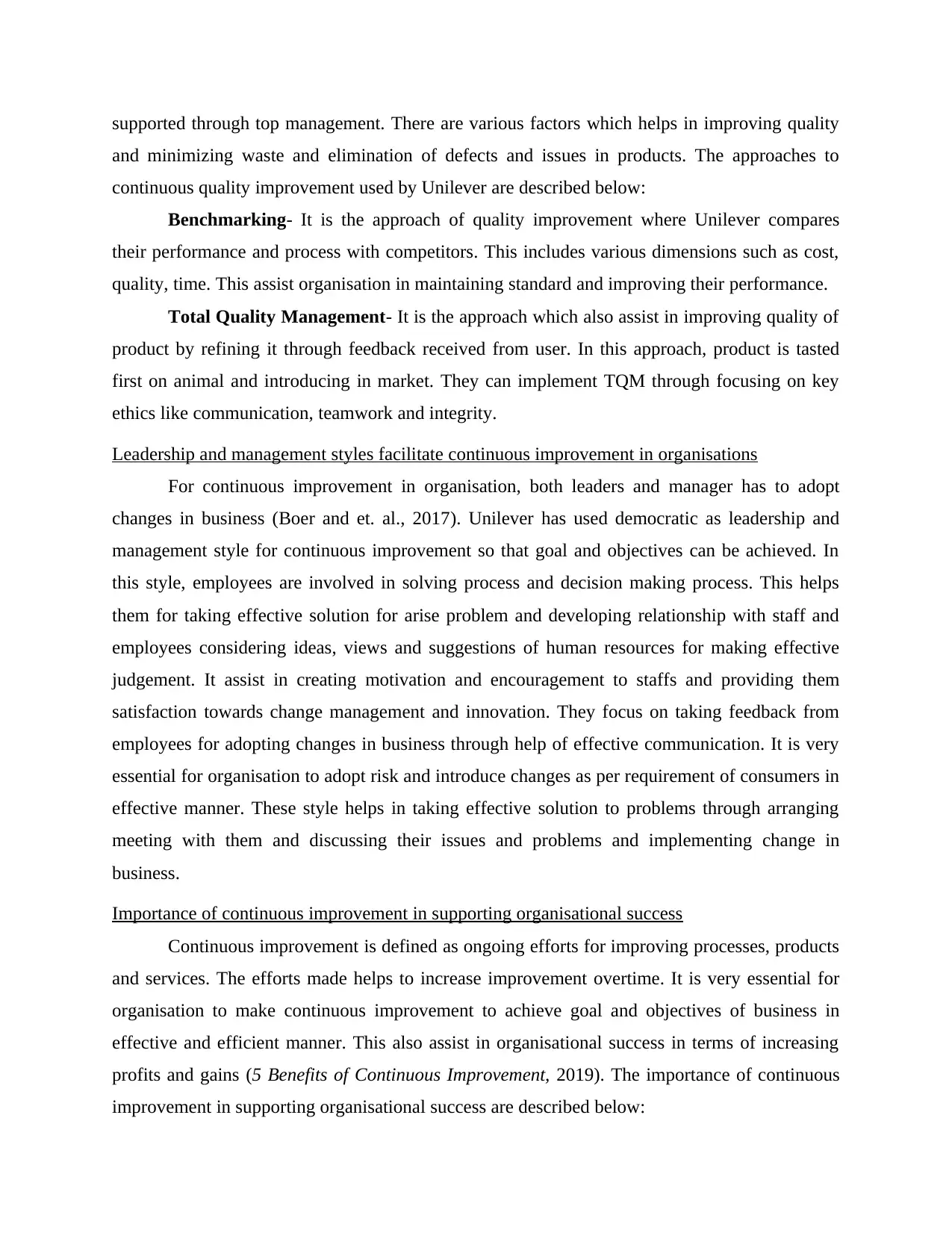
supported through top management. There are various factors which helps in improving quality
and minimizing waste and elimination of defects and issues in products. The approaches to
continuous quality improvement used by Unilever are described below:
Benchmarking- It is the approach of quality improvement where Unilever compares
their performance and process with competitors. This includes various dimensions such as cost,
quality, time. This assist organisation in maintaining standard and improving their performance.
Total Quality Management- It is the approach which also assist in improving quality of
product by refining it through feedback received from user. In this approach, product is tasted
first on animal and introducing in market. They can implement TQM through focusing on key
ethics like communication, teamwork and integrity.
Leadership and management styles facilitate continuous improvement in organisations
For continuous improvement in organisation, both leaders and manager has to adopt
changes in business (Boer and et. al., 2017). Unilever has used democratic as leadership and
management style for continuous improvement so that goal and objectives can be achieved. In
this style, employees are involved in solving process and decision making process. This helps
them for taking effective solution for arise problem and developing relationship with staff and
employees considering ideas, views and suggestions of human resources for making effective
judgement. It assist in creating motivation and encouragement to staffs and providing them
satisfaction towards change management and innovation. They focus on taking feedback from
employees for adopting changes in business through help of effective communication. It is very
essential for organisation to adopt risk and introduce changes as per requirement of consumers in
effective manner. These style helps in taking effective solution to problems through arranging
meeting with them and discussing their issues and problems and implementing change in
business.
Importance of continuous improvement in supporting organisational success
Continuous improvement is defined as ongoing efforts for improving processes, products
and services. The efforts made helps to increase improvement overtime. It is very essential for
organisation to make continuous improvement to achieve goal and objectives of business in
effective and efficient manner. This also assist in organisational success in terms of increasing
profits and gains (5 Benefits of Continuous Improvement, 2019). The importance of continuous
improvement in supporting organisational success are described below:
and minimizing waste and elimination of defects and issues in products. The approaches to
continuous quality improvement used by Unilever are described below:
Benchmarking- It is the approach of quality improvement where Unilever compares
their performance and process with competitors. This includes various dimensions such as cost,
quality, time. This assist organisation in maintaining standard and improving their performance.
Total Quality Management- It is the approach which also assist in improving quality of
product by refining it through feedback received from user. In this approach, product is tasted
first on animal and introducing in market. They can implement TQM through focusing on key
ethics like communication, teamwork and integrity.
Leadership and management styles facilitate continuous improvement in organisations
For continuous improvement in organisation, both leaders and manager has to adopt
changes in business (Boer and et. al., 2017). Unilever has used democratic as leadership and
management style for continuous improvement so that goal and objectives can be achieved. In
this style, employees are involved in solving process and decision making process. This helps
them for taking effective solution for arise problem and developing relationship with staff and
employees considering ideas, views and suggestions of human resources for making effective
judgement. It assist in creating motivation and encouragement to staffs and providing them
satisfaction towards change management and innovation. They focus on taking feedback from
employees for adopting changes in business through help of effective communication. It is very
essential for organisation to adopt risk and introduce changes as per requirement of consumers in
effective manner. These style helps in taking effective solution to problems through arranging
meeting with them and discussing their issues and problems and implementing change in
business.
Importance of continuous improvement in supporting organisational success
Continuous improvement is defined as ongoing efforts for improving processes, products
and services. The efforts made helps to increase improvement overtime. It is very essential for
organisation to make continuous improvement to achieve goal and objectives of business in
effective and efficient manner. This also assist in organisational success in terms of increasing
profits and gains (5 Benefits of Continuous Improvement, 2019). The importance of continuous
improvement in supporting organisational success are described below:
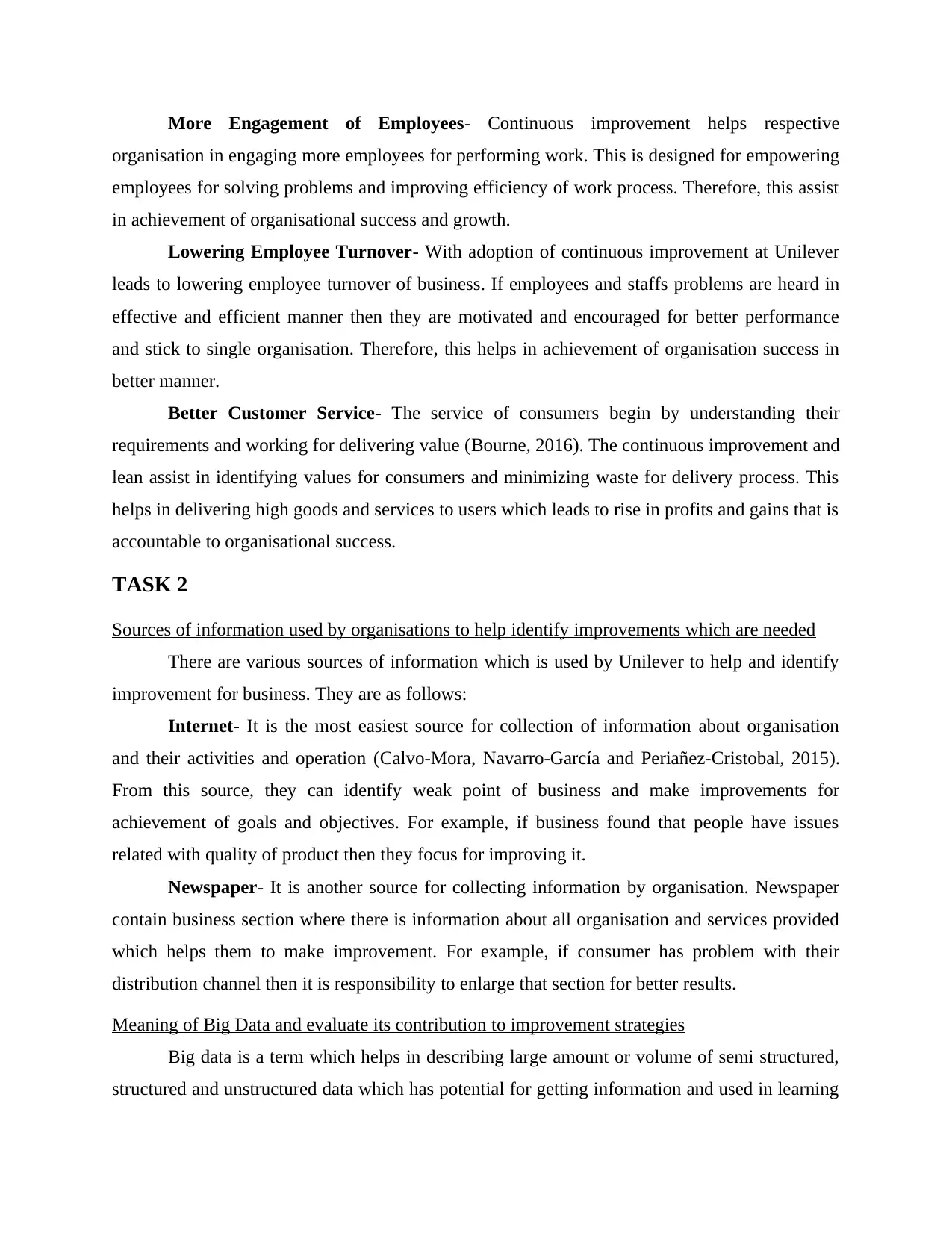
More Engagement of Employees- Continuous improvement helps respective
organisation in engaging more employees for performing work. This is designed for empowering
employees for solving problems and improving efficiency of work process. Therefore, this assist
in achievement of organisational success and growth.
Lowering Employee Turnover- With adoption of continuous improvement at Unilever
leads to lowering employee turnover of business. If employees and staffs problems are heard in
effective and efficient manner then they are motivated and encouraged for better performance
and stick to single organisation. Therefore, this helps in achievement of organisation success in
better manner.
Better Customer Service- The service of consumers begin by understanding their
requirements and working for delivering value (Bourne, 2016). The continuous improvement and
lean assist in identifying values for consumers and minimizing waste for delivery process. This
helps in delivering high goods and services to users which leads to rise in profits and gains that is
accountable to organisational success.
TASK 2
Sources of information used by organisations to help identify improvements which are needed
There are various sources of information which is used by Unilever to help and identify
improvement for business. They are as follows:
Internet- It is the most easiest source for collection of information about organisation
and their activities and operation (Calvo-Mora, Navarro-García and Periañez-Cristobal, 2015).
From this source, they can identify weak point of business and make improvements for
achievement of goals and objectives. For example, if business found that people have issues
related with quality of product then they focus for improving it.
Newspaper- It is another source for collecting information by organisation. Newspaper
contain business section where there is information about all organisation and services provided
which helps them to make improvement. For example, if consumer has problem with their
distribution channel then it is responsibility to enlarge that section for better results.
Meaning of Big Data and evaluate its contribution to improvement strategies
Big data is a term which helps in describing large amount or volume of semi structured,
structured and unstructured data which has potential for getting information and used in learning
organisation in engaging more employees for performing work. This is designed for empowering
employees for solving problems and improving efficiency of work process. Therefore, this assist
in achievement of organisational success and growth.
Lowering Employee Turnover- With adoption of continuous improvement at Unilever
leads to lowering employee turnover of business. If employees and staffs problems are heard in
effective and efficient manner then they are motivated and encouraged for better performance
and stick to single organisation. Therefore, this helps in achievement of organisation success in
better manner.
Better Customer Service- The service of consumers begin by understanding their
requirements and working for delivering value (Bourne, 2016). The continuous improvement and
lean assist in identifying values for consumers and minimizing waste for delivery process. This
helps in delivering high goods and services to users which leads to rise in profits and gains that is
accountable to organisational success.
TASK 2
Sources of information used by organisations to help identify improvements which are needed
There are various sources of information which is used by Unilever to help and identify
improvement for business. They are as follows:
Internet- It is the most easiest source for collection of information about organisation
and their activities and operation (Calvo-Mora, Navarro-García and Periañez-Cristobal, 2015).
From this source, they can identify weak point of business and make improvements for
achievement of goals and objectives. For example, if business found that people have issues
related with quality of product then they focus for improving it.
Newspaper- It is another source for collecting information by organisation. Newspaper
contain business section where there is information about all organisation and services provided
which helps them to make improvement. For example, if consumer has problem with their
distribution channel then it is responsibility to enlarge that section for better results.
Meaning of Big Data and evaluate its contribution to improvement strategies
Big data is a term which helps in describing large amount or volume of semi structured,
structured and unstructured data which has potential for getting information and used in learning
⊘ This is a preview!⊘
Do you want full access?
Subscribe today to unlock all pages.

Trusted by 1+ million students worldwide
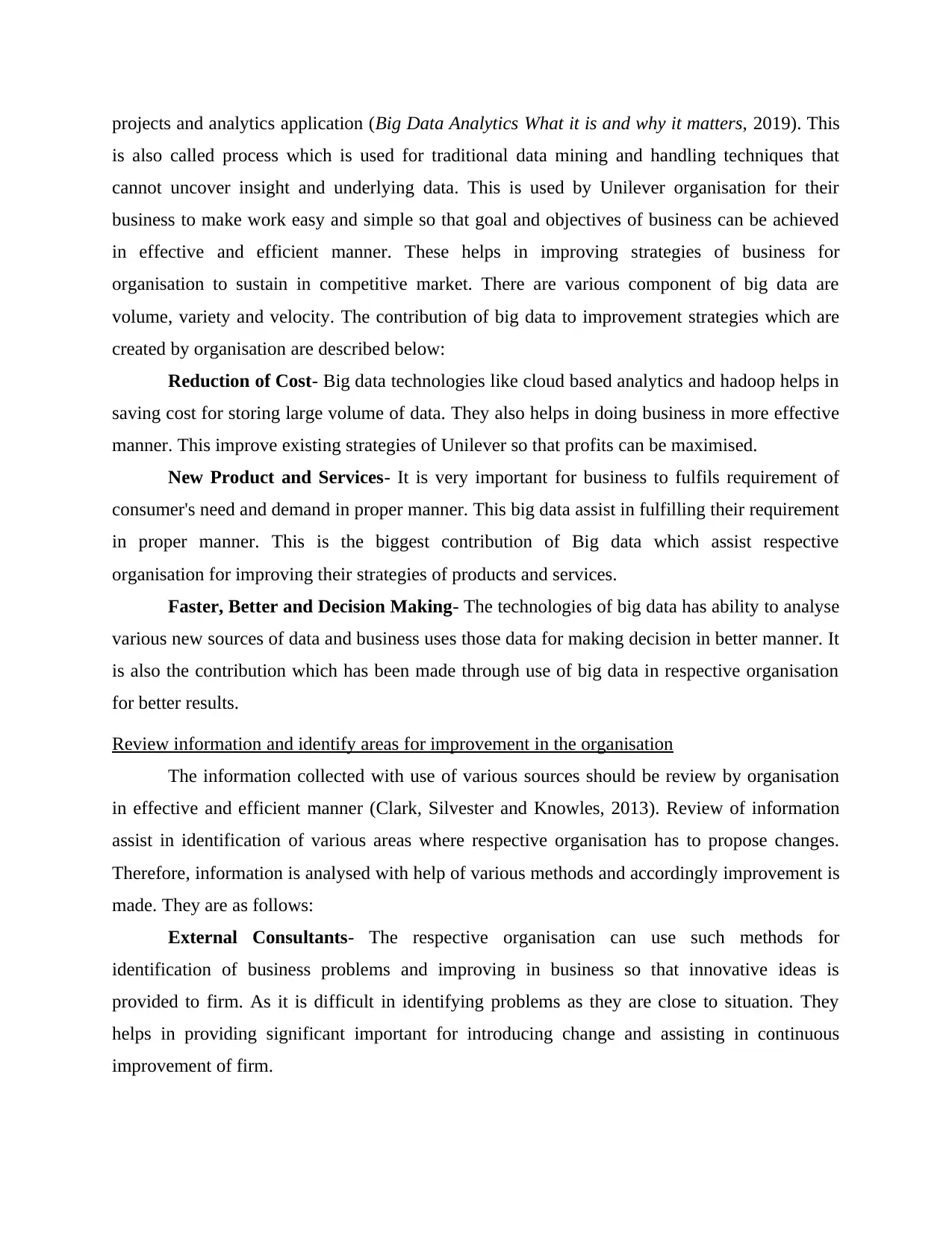
projects and analytics application (Big Data Analytics What it is and why it matters, 2019). This
is also called process which is used for traditional data mining and handling techniques that
cannot uncover insight and underlying data. This is used by Unilever organisation for their
business to make work easy and simple so that goal and objectives of business can be achieved
in effective and efficient manner. These helps in improving strategies of business for
organisation to sustain in competitive market. There are various component of big data are
volume, variety and velocity. The contribution of big data to improvement strategies which are
created by organisation are described below:
Reduction of Cost- Big data technologies like cloud based analytics and hadoop helps in
saving cost for storing large volume of data. They also helps in doing business in more effective
manner. This improve existing strategies of Unilever so that profits can be maximised.
New Product and Services- It is very important for business to fulfils requirement of
consumer's need and demand in proper manner. This big data assist in fulfilling their requirement
in proper manner. This is the biggest contribution of Big data which assist respective
organisation for improving their strategies of products and services.
Faster, Better and Decision Making- The technologies of big data has ability to analyse
various new sources of data and business uses those data for making decision in better manner. It
is also the contribution which has been made through use of big data in respective organisation
for better results.
Review information and identify areas for improvement in the organisation
The information collected with use of various sources should be review by organisation
in effective and efficient manner (Clark, Silvester and Knowles, 2013). Review of information
assist in identification of various areas where respective organisation has to propose changes.
Therefore, information is analysed with help of various methods and accordingly improvement is
made. They are as follows:
External Consultants- The respective organisation can use such methods for
identification of business problems and improving in business so that innovative ideas is
provided to firm. As it is difficult in identifying problems as they are close to situation. They
helps in providing significant important for introducing change and assisting in continuous
improvement of firm.
is also called process which is used for traditional data mining and handling techniques that
cannot uncover insight and underlying data. This is used by Unilever organisation for their
business to make work easy and simple so that goal and objectives of business can be achieved
in effective and efficient manner. These helps in improving strategies of business for
organisation to sustain in competitive market. There are various component of big data are
volume, variety and velocity. The contribution of big data to improvement strategies which are
created by organisation are described below:
Reduction of Cost- Big data technologies like cloud based analytics and hadoop helps in
saving cost for storing large volume of data. They also helps in doing business in more effective
manner. This improve existing strategies of Unilever so that profits can be maximised.
New Product and Services- It is very important for business to fulfils requirement of
consumer's need and demand in proper manner. This big data assist in fulfilling their requirement
in proper manner. This is the biggest contribution of Big data which assist respective
organisation for improving their strategies of products and services.
Faster, Better and Decision Making- The technologies of big data has ability to analyse
various new sources of data and business uses those data for making decision in better manner. It
is also the contribution which has been made through use of big data in respective organisation
for better results.
Review information and identify areas for improvement in the organisation
The information collected with use of various sources should be review by organisation
in effective and efficient manner (Clark, Silvester and Knowles, 2013). Review of information
assist in identification of various areas where respective organisation has to propose changes.
Therefore, information is analysed with help of various methods and accordingly improvement is
made. They are as follows:
External Consultants- The respective organisation can use such methods for
identification of business problems and improving in business so that innovative ideas is
provided to firm. As it is difficult in identifying problems as they are close to situation. They
helps in providing significant important for introducing change and assisting in continuous
improvement of firm.
Paraphrase This Document
Need a fresh take? Get an instant paraphrase of this document with our AI Paraphraser
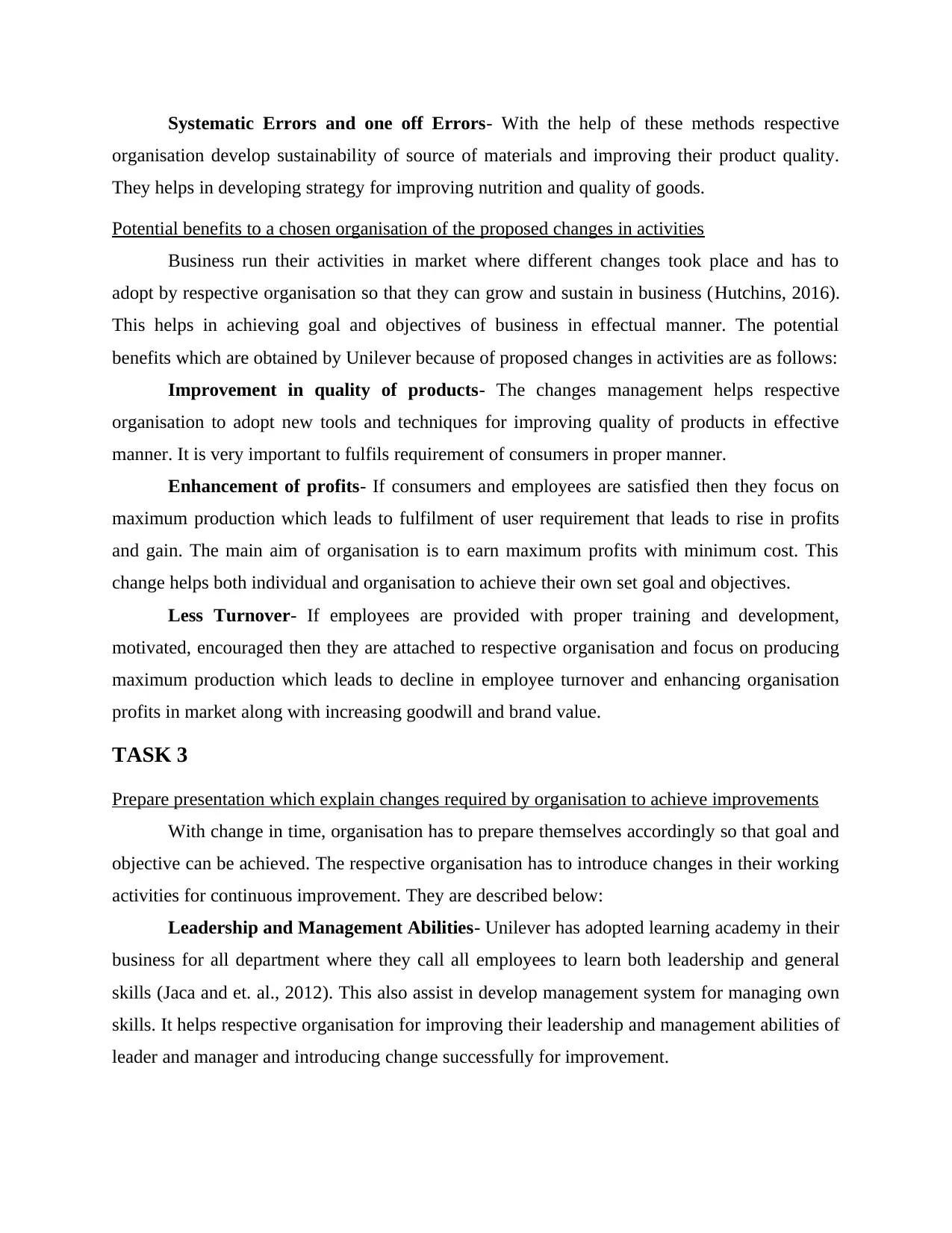
Systematic Errors and one off Errors- With the help of these methods respective
organisation develop sustainability of source of materials and improving their product quality.
They helps in developing strategy for improving nutrition and quality of goods.
Potential benefits to a chosen organisation of the proposed changes in activities
Business run their activities in market where different changes took place and has to
adopt by respective organisation so that they can grow and sustain in business (Hutchins, 2016).
This helps in achieving goal and objectives of business in effectual manner. The potential
benefits which are obtained by Unilever because of proposed changes in activities are as follows:
Improvement in quality of products- The changes management helps respective
organisation to adopt new tools and techniques for improving quality of products in effective
manner. It is very important to fulfils requirement of consumers in proper manner.
Enhancement of profits- If consumers and employees are satisfied then they focus on
maximum production which leads to fulfilment of user requirement that leads to rise in profits
and gain. The main aim of organisation is to earn maximum profits with minimum cost. This
change helps both individual and organisation to achieve their own set goal and objectives.
Less Turnover- If employees are provided with proper training and development,
motivated, encouraged then they are attached to respective organisation and focus on producing
maximum production which leads to decline in employee turnover and enhancing organisation
profits in market along with increasing goodwill and brand value.
TASK 3
Prepare presentation which explain changes required by organisation to achieve improvements
With change in time, organisation has to prepare themselves accordingly so that goal and
objective can be achieved. The respective organisation has to introduce changes in their working
activities for continuous improvement. They are described below:
Leadership and Management Abilities- Unilever has adopted learning academy in their
business for all department where they call all employees to learn both leadership and general
skills (Jaca and et. al., 2012). This also assist in develop management system for managing own
skills. It helps respective organisation for improving their leadership and management abilities of
leader and manager and introducing change successfully for improvement.
organisation develop sustainability of source of materials and improving their product quality.
They helps in developing strategy for improving nutrition and quality of goods.
Potential benefits to a chosen organisation of the proposed changes in activities
Business run their activities in market where different changes took place and has to
adopt by respective organisation so that they can grow and sustain in business (Hutchins, 2016).
This helps in achieving goal and objectives of business in effectual manner. The potential
benefits which are obtained by Unilever because of proposed changes in activities are as follows:
Improvement in quality of products- The changes management helps respective
organisation to adopt new tools and techniques for improving quality of products in effective
manner. It is very important to fulfils requirement of consumers in proper manner.
Enhancement of profits- If consumers and employees are satisfied then they focus on
maximum production which leads to fulfilment of user requirement that leads to rise in profits
and gain. The main aim of organisation is to earn maximum profits with minimum cost. This
change helps both individual and organisation to achieve their own set goal and objectives.
Less Turnover- If employees are provided with proper training and development,
motivated, encouraged then they are attached to respective organisation and focus on producing
maximum production which leads to decline in employee turnover and enhancing organisation
profits in market along with increasing goodwill and brand value.
TASK 3
Prepare presentation which explain changes required by organisation to achieve improvements
With change in time, organisation has to prepare themselves accordingly so that goal and
objective can be achieved. The respective organisation has to introduce changes in their working
activities for continuous improvement. They are described below:
Leadership and Management Abilities- Unilever has adopted learning academy in their
business for all department where they call all employees to learn both leadership and general
skills (Jaca and et. al., 2012). This also assist in develop management system for managing own
skills. It helps respective organisation for improving their leadership and management abilities of
leader and manager and introducing change successfully for improvement.
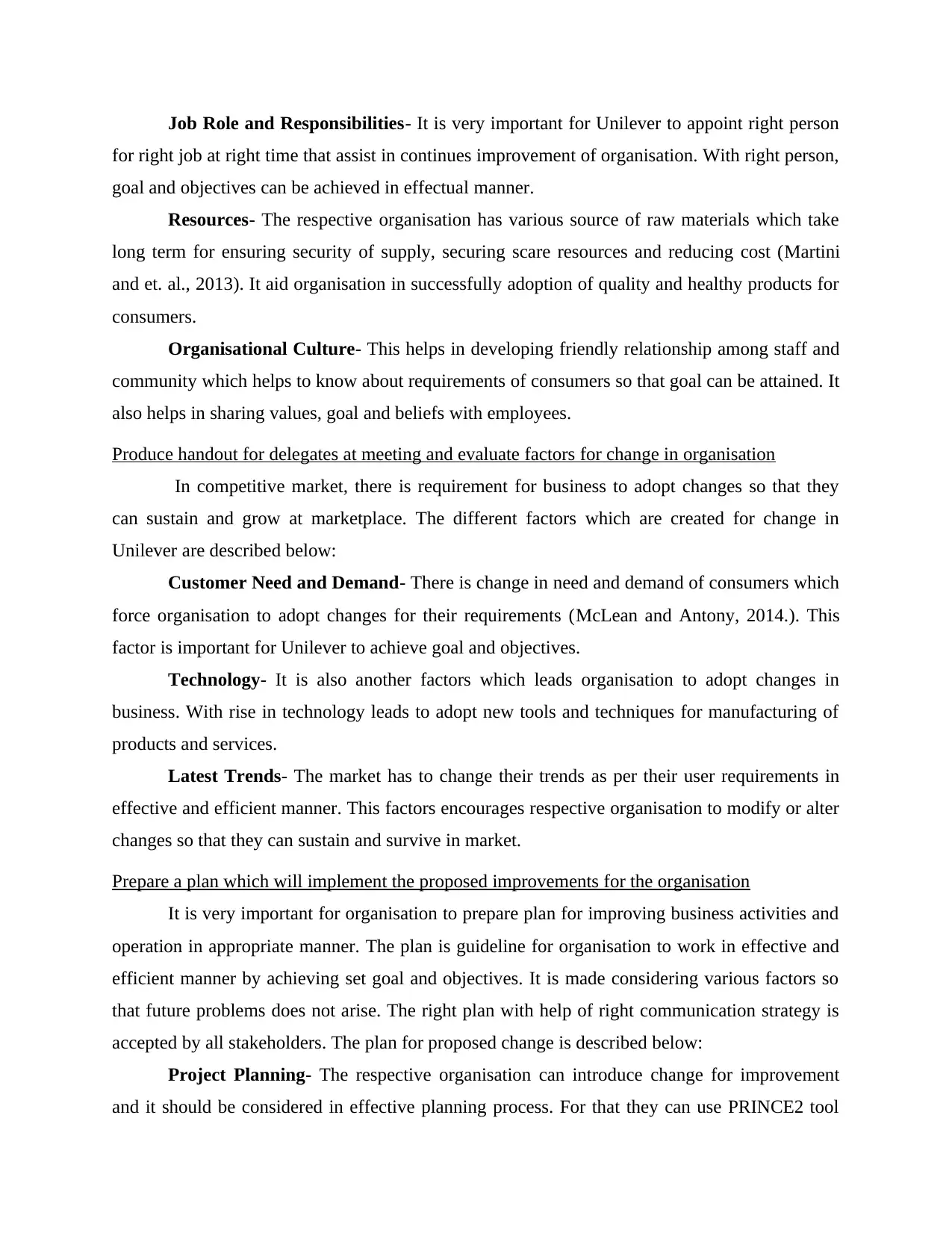
Job Role and Responsibilities- It is very important for Unilever to appoint right person
for right job at right time that assist in continues improvement of organisation. With right person,
goal and objectives can be achieved in effectual manner.
Resources- The respective organisation has various source of raw materials which take
long term for ensuring security of supply, securing scare resources and reducing cost (Martini
and et. al., 2013). It aid organisation in successfully adoption of quality and healthy products for
consumers.
Organisational Culture- This helps in developing friendly relationship among staff and
community which helps to know about requirements of consumers so that goal can be attained. It
also helps in sharing values, goal and beliefs with employees.
Produce handout for delegates at meeting and evaluate factors for change in organisation
In competitive market, there is requirement for business to adopt changes so that they
can sustain and grow at marketplace. The different factors which are created for change in
Unilever are described below:
Customer Need and Demand- There is change in need and demand of consumers which
force organisation to adopt changes for their requirements (McLean and Antony, 2014.). This
factor is important for Unilever to achieve goal and objectives.
Technology- It is also another factors which leads organisation to adopt changes in
business. With rise in technology leads to adopt new tools and techniques for manufacturing of
products and services.
Latest Trends- The market has to change their trends as per their user requirements in
effective and efficient manner. This factors encourages respective organisation to modify or alter
changes so that they can sustain and survive in market.
Prepare a plan which will implement the proposed improvements for the organisation
It is very important for organisation to prepare plan for improving business activities and
operation in appropriate manner. The plan is guideline for organisation to work in effective and
efficient manner by achieving set goal and objectives. It is made considering various factors so
that future problems does not arise. The right plan with help of right communication strategy is
accepted by all stakeholders. The plan for proposed change is described below:
Project Planning- The respective organisation can introduce change for improvement
and it should be considered in effective planning process. For that they can use PRINCE2 tool
for right job at right time that assist in continues improvement of organisation. With right person,
goal and objectives can be achieved in effectual manner.
Resources- The respective organisation has various source of raw materials which take
long term for ensuring security of supply, securing scare resources and reducing cost (Martini
and et. al., 2013). It aid organisation in successfully adoption of quality and healthy products for
consumers.
Organisational Culture- This helps in developing friendly relationship among staff and
community which helps to know about requirements of consumers so that goal can be attained. It
also helps in sharing values, goal and beliefs with employees.
Produce handout for delegates at meeting and evaluate factors for change in organisation
In competitive market, there is requirement for business to adopt changes so that they
can sustain and grow at marketplace. The different factors which are created for change in
Unilever are described below:
Customer Need and Demand- There is change in need and demand of consumers which
force organisation to adopt changes for their requirements (McLean and Antony, 2014.). This
factor is important for Unilever to achieve goal and objectives.
Technology- It is also another factors which leads organisation to adopt changes in
business. With rise in technology leads to adopt new tools and techniques for manufacturing of
products and services.
Latest Trends- The market has to change their trends as per their user requirements in
effective and efficient manner. This factors encourages respective organisation to modify or alter
changes so that they can sustain and survive in market.
Prepare a plan which will implement the proposed improvements for the organisation
It is very important for organisation to prepare plan for improving business activities and
operation in appropriate manner. The plan is guideline for organisation to work in effective and
efficient manner by achieving set goal and objectives. It is made considering various factors so
that future problems does not arise. The right plan with help of right communication strategy is
accepted by all stakeholders. The plan for proposed change is described below:
Project Planning- The respective organisation can introduce change for improvement
and it should be considered in effective planning process. For that they can use PRINCE2 tool
⊘ This is a preview!⊘
Do you want full access?
Subscribe today to unlock all pages.

Trusted by 1+ million students worldwide
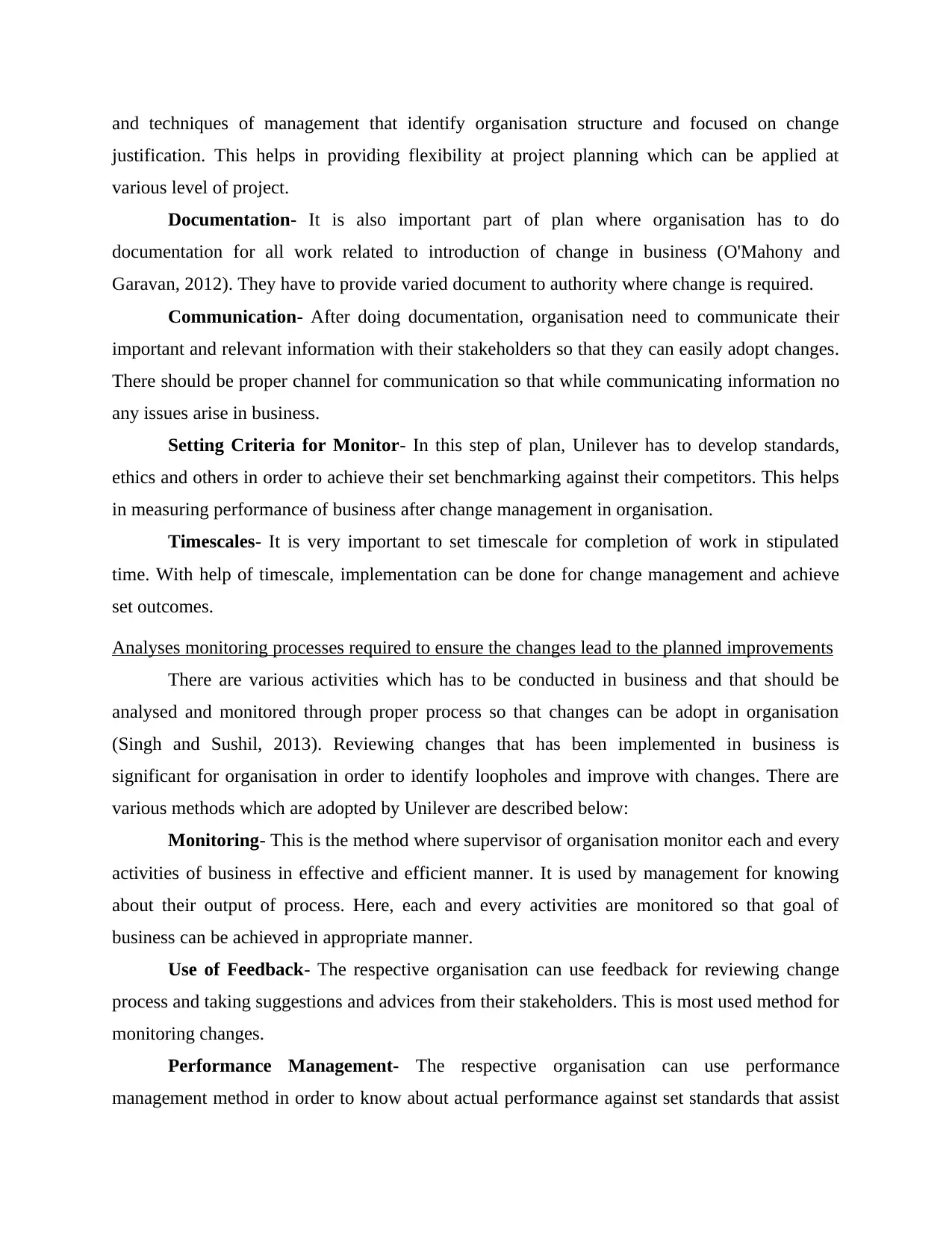
and techniques of management that identify organisation structure and focused on change
justification. This helps in providing flexibility at project planning which can be applied at
various level of project.
Documentation- It is also important part of plan where organisation has to do
documentation for all work related to introduction of change in business (O'Mahony and
Garavan, 2012). They have to provide varied document to authority where change is required.
Communication- After doing documentation, organisation need to communicate their
important and relevant information with their stakeholders so that they can easily adopt changes.
There should be proper channel for communication so that while communicating information no
any issues arise in business.
Setting Criteria for Monitor- In this step of plan, Unilever has to develop standards,
ethics and others in order to achieve their set benchmarking against their competitors. This helps
in measuring performance of business after change management in organisation.
Timescales- It is very important to set timescale for completion of work in stipulated
time. With help of timescale, implementation can be done for change management and achieve
set outcomes.
Analyses monitoring processes required to ensure the changes lead to the planned improvements
There are various activities which has to be conducted in business and that should be
analysed and monitored through proper process so that changes can be adopt in organisation
(Singh and Sushil, 2013). Reviewing changes that has been implemented in business is
significant for organisation in order to identify loopholes and improve with changes. There are
various methods which are adopted by Unilever are described below:
Monitoring- This is the method where supervisor of organisation monitor each and every
activities of business in effective and efficient manner. It is used by management for knowing
about their output of process. Here, each and every activities are monitored so that goal of
business can be achieved in appropriate manner.
Use of Feedback- The respective organisation can use feedback for reviewing change
process and taking suggestions and advices from their stakeholders. This is most used method for
monitoring changes.
Performance Management- The respective organisation can use performance
management method in order to know about actual performance against set standards that assist
justification. This helps in providing flexibility at project planning which can be applied at
various level of project.
Documentation- It is also important part of plan where organisation has to do
documentation for all work related to introduction of change in business (O'Mahony and
Garavan, 2012). They have to provide varied document to authority where change is required.
Communication- After doing documentation, organisation need to communicate their
important and relevant information with their stakeholders so that they can easily adopt changes.
There should be proper channel for communication so that while communicating information no
any issues arise in business.
Setting Criteria for Monitor- In this step of plan, Unilever has to develop standards,
ethics and others in order to achieve their set benchmarking against their competitors. This helps
in measuring performance of business after change management in organisation.
Timescales- It is very important to set timescale for completion of work in stipulated
time. With help of timescale, implementation can be done for change management and achieve
set outcomes.
Analyses monitoring processes required to ensure the changes lead to the planned improvements
There are various activities which has to be conducted in business and that should be
analysed and monitored through proper process so that changes can be adopt in organisation
(Singh and Sushil, 2013). Reviewing changes that has been implemented in business is
significant for organisation in order to identify loopholes and improve with changes. There are
various methods which are adopted by Unilever are described below:
Monitoring- This is the method where supervisor of organisation monitor each and every
activities of business in effective and efficient manner. It is used by management for knowing
about their output of process. Here, each and every activities are monitored so that goal of
business can be achieved in appropriate manner.
Use of Feedback- The respective organisation can use feedback for reviewing change
process and taking suggestions and advices from their stakeholders. This is most used method for
monitoring changes.
Performance Management- The respective organisation can use performance
management method in order to know about actual performance against set standards that assist
Paraphrase This Document
Need a fresh take? Get an instant paraphrase of this document with our AI Paraphraser
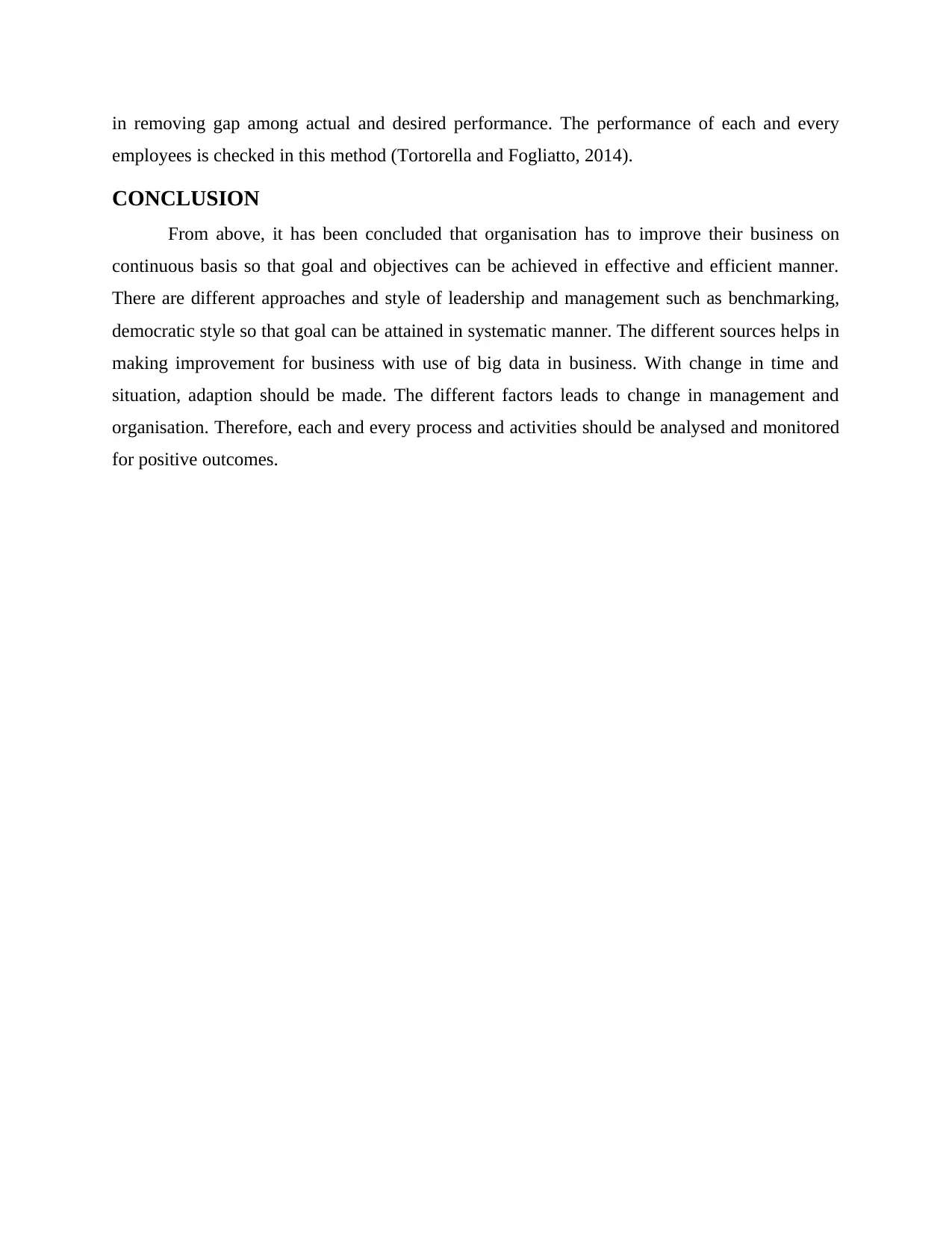
in removing gap among actual and desired performance. The performance of each and every
employees is checked in this method (Tortorella and Fogliatto, 2014).
CONCLUSION
From above, it has been concluded that organisation has to improve their business on
continuous basis so that goal and objectives can be achieved in effective and efficient manner.
There are different approaches and style of leadership and management such as benchmarking,
democratic style so that goal can be attained in systematic manner. The different sources helps in
making improvement for business with use of big data in business. With change in time and
situation, adaption should be made. The different factors leads to change in management and
organisation. Therefore, each and every process and activities should be analysed and monitored
for positive outcomes.
employees is checked in this method (Tortorella and Fogliatto, 2014).
CONCLUSION
From above, it has been concluded that organisation has to improve their business on
continuous basis so that goal and objectives can be achieved in effective and efficient manner.
There are different approaches and style of leadership and management such as benchmarking,
democratic style so that goal can be attained in systematic manner. The different sources helps in
making improvement for business with use of big data in business. With change in time and
situation, adaption should be made. The different factors leads to change in management and
organisation. Therefore, each and every process and activities should be analysed and monitored
for positive outcomes.
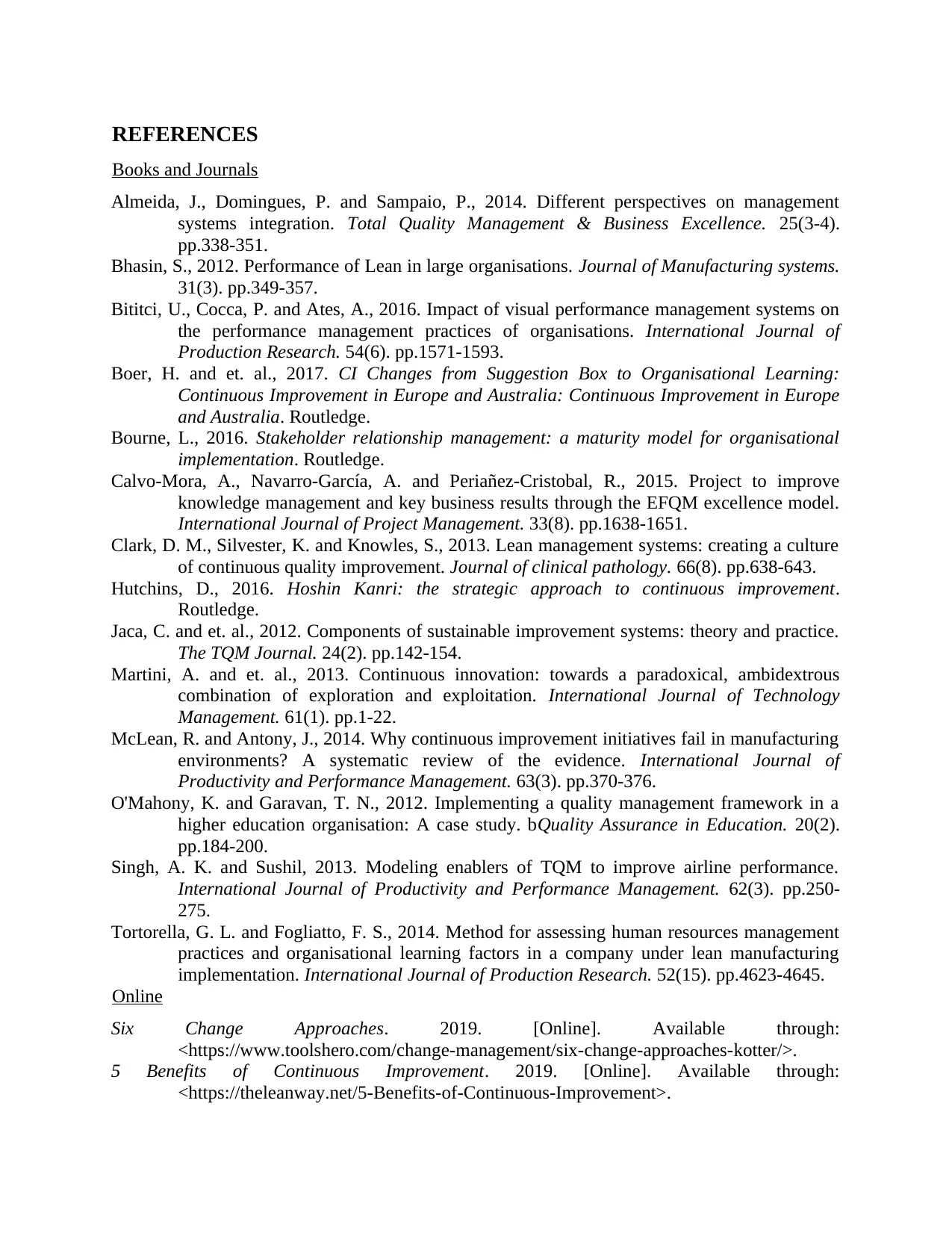
REFERENCES
Books and Journals
Almeida, J., Domingues, P. and Sampaio, P., 2014. Different perspectives on management
systems integration. Total Quality Management & Business Excellence. 25(3-4).
pp.338-351.
Bhasin, S., 2012. Performance of Lean in large organisations. Journal of Manufacturing systems.
31(3). pp.349-357.
Bititci, U., Cocca, P. and Ates, A., 2016. Impact of visual performance management systems on
the performance management practices of organisations. International Journal of
Production Research. 54(6). pp.1571-1593.
Boer, H. and et. al., 2017. CI Changes from Suggestion Box to Organisational Learning:
Continuous Improvement in Europe and Australia: Continuous Improvement in Europe
and Australia. Routledge.
Bourne, L., 2016. Stakeholder relationship management: a maturity model for organisational
implementation. Routledge.
Calvo-Mora, A., Navarro-García, A. and Periañez-Cristobal, R., 2015. Project to improve
knowledge management and key business results through the EFQM excellence model.
International Journal of Project Management. 33(8). pp.1638-1651.
Clark, D. M., Silvester, K. and Knowles, S., 2013. Lean management systems: creating a culture
of continuous quality improvement. Journal of clinical pathology. 66(8). pp.638-643.
Hutchins, D., 2016. Hoshin Kanri: the strategic approach to continuous improvement.
Routledge.
Jaca, C. and et. al., 2012. Components of sustainable improvement systems: theory and practice.
The TQM Journal. 24(2). pp.142-154.
Martini, A. and et. al., 2013. Continuous innovation: towards a paradoxical, ambidextrous
combination of exploration and exploitation. International Journal of Technology
Management. 61(1). pp.1-22.
McLean, R. and Antony, J., 2014. Why continuous improvement initiatives fail in manufacturing
environments? A systematic review of the evidence. International Journal of
Productivity and Performance Management. 63(3). pp.370-376.
O'Mahony, K. and Garavan, T. N., 2012. Implementing a quality management framework in a
higher education organisation: A case study. bQuality Assurance in Education. 20(2).
pp.184-200.
Singh, A. K. and Sushil, 2013. Modeling enablers of TQM to improve airline performance.
International Journal of Productivity and Performance Management. 62(3). pp.250-
275.
Tortorella, G. L. and Fogliatto, F. S., 2014. Method for assessing human resources management
practices and organisational learning factors in a company under lean manufacturing
implementation. International Journal of Production Research. 52(15). pp.4623-4645.
Online
Six Change Approaches. 2019. [Online]. Available through:
<https://www.toolshero.com/change-management/six-change-approaches-kotter/>.
5 Benefits of Continuous Improvement. 2019. [Online]. Available through:
<https://theleanway.net/5-Benefits-of-Continuous-Improvement>.
Books and Journals
Almeida, J., Domingues, P. and Sampaio, P., 2014. Different perspectives on management
systems integration. Total Quality Management & Business Excellence. 25(3-4).
pp.338-351.
Bhasin, S., 2012. Performance of Lean in large organisations. Journal of Manufacturing systems.
31(3). pp.349-357.
Bititci, U., Cocca, P. and Ates, A., 2016. Impact of visual performance management systems on
the performance management practices of organisations. International Journal of
Production Research. 54(6). pp.1571-1593.
Boer, H. and et. al., 2017. CI Changes from Suggestion Box to Organisational Learning:
Continuous Improvement in Europe and Australia: Continuous Improvement in Europe
and Australia. Routledge.
Bourne, L., 2016. Stakeholder relationship management: a maturity model for organisational
implementation. Routledge.
Calvo-Mora, A., Navarro-García, A. and Periañez-Cristobal, R., 2015. Project to improve
knowledge management and key business results through the EFQM excellence model.
International Journal of Project Management. 33(8). pp.1638-1651.
Clark, D. M., Silvester, K. and Knowles, S., 2013. Lean management systems: creating a culture
of continuous quality improvement. Journal of clinical pathology. 66(8). pp.638-643.
Hutchins, D., 2016. Hoshin Kanri: the strategic approach to continuous improvement.
Routledge.
Jaca, C. and et. al., 2012. Components of sustainable improvement systems: theory and practice.
The TQM Journal. 24(2). pp.142-154.
Martini, A. and et. al., 2013. Continuous innovation: towards a paradoxical, ambidextrous
combination of exploration and exploitation. International Journal of Technology
Management. 61(1). pp.1-22.
McLean, R. and Antony, J., 2014. Why continuous improvement initiatives fail in manufacturing
environments? A systematic review of the evidence. International Journal of
Productivity and Performance Management. 63(3). pp.370-376.
O'Mahony, K. and Garavan, T. N., 2012. Implementing a quality management framework in a
higher education organisation: A case study. bQuality Assurance in Education. 20(2).
pp.184-200.
Singh, A. K. and Sushil, 2013. Modeling enablers of TQM to improve airline performance.
International Journal of Productivity and Performance Management. 62(3). pp.250-
275.
Tortorella, G. L. and Fogliatto, F. S., 2014. Method for assessing human resources management
practices and organisational learning factors in a company under lean manufacturing
implementation. International Journal of Production Research. 52(15). pp.4623-4645.
Online
Six Change Approaches. 2019. [Online]. Available through:
<https://www.toolshero.com/change-management/six-change-approaches-kotter/>.
5 Benefits of Continuous Improvement. 2019. [Online]. Available through:
<https://theleanway.net/5-Benefits-of-Continuous-Improvement>.
⊘ This is a preview!⊘
Do you want full access?
Subscribe today to unlock all pages.

Trusted by 1+ million students worldwide
1 out of 13
Related Documents
Your All-in-One AI-Powered Toolkit for Academic Success.
+13062052269
info@desklib.com
Available 24*7 on WhatsApp / Email
![[object Object]](/_next/static/media/star-bottom.7253800d.svg)
Unlock your academic potential
Copyright © 2020–2025 A2Z Services. All Rights Reserved. Developed and managed by ZUCOL.





